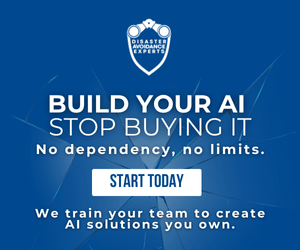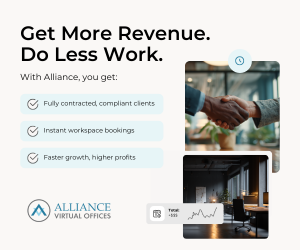- With longer life expectancies, more older workers are choosing to stay in the workforce, seeking flexible and supportive environments that cater to their needs.
- Coworking spaces are evolving to offer accessible designs, customizable workspaces, and wellness programs that prioritize comfort, health, and productivity for older professionals.
- These spaces promote intergenerational collaboration by offering mentorship opportunities, networking events, and peer-to-peer learning, creating a thriving, diverse community.
The number of older workers — those 65 and up — has been steadily rising, as more people choose to stay in the workforce beyond traditional retirement age, whether out of necessity, passion, or simply a desire to remain mentally engaged.
These workers might prefer coworking spaces — shared office environments offering flexible work options, networking opportunities, and essential amenities — because they provide a vibrant, supportive setting that keeps them connected and productive without the rigidity of a traditional office.
With more and more people working later into life, coworking spaces are now starting to cater to a much older, and often more experienced, generation of workers.
There’s even a coworking space just for seniors in New York called Senior Planet.
As the workforce ages, these spaces are adapting to make sure that people of all ages can find a comfortable and productive place to work — it’s about creating environments that support a diverse range of people, experiences, and needs.
So, what does a coworking space look like when it’s designed for a more seasoned workforce?
1. Design for Comfort and Accessibility
For many older workers, physical comfort is key. While younger generations might tolerate minimalist, industrial-style office setups, older workers often appreciate designs that make the space feel more accessible and user-friendly.
This means coworking spaces are paying more attention to things like ergonomic furniture, proper lighting, and easy-to-navigate layouts.
Ergonomic Furniture
You’ll find more chairs that support posture, desks that adjust for sitting or standing, and even specialized equipment like keyboard trays to reduce strain. These upgrades aren’t just nice-to-haves; they’re essential for people who may be dealing with joint pain or other mobility issues.
Accessible Layouts
Walkways and doorways are wider, and spaces are designed to be free of obstructions. Many coworking spaces also focus on having elevators and ramps for easy access, making sure that mobility challenges don’t keep anyone from feeling at home.
Lighting and Acoustics
Older eyes are more sensitive to glare and harsh lighting, so spaces are designed with softer, ambient lighting. Acoustic considerations are also becoming more important, as older workers might find it harder to concentrate in noisy environments. Quiet zones or soundproof booths allow for focused work and conference calls without distractions.
2. Flexibility and Customization
Older remote workers are often looking for a different kind of work-life balance. They might still want the energy of a community, but prefer more flexible hours and customized workspaces that suit their specific needs. Many coworking spaces are adapting by offering pay-as-you-go models, rather than the traditional membership with a long-term commitment.
Short-Term Options
For those who don’t need to work full-time from a coworking space, day passes, part-time memberships, or even pay-per-use arrangements give them the freedom to come in when they need it without feeling tied down.
Customizable Spaces
As remote work becomes more common, older workers often prefer spaces that can be tailored to their needs. Some coworking spaces now offer private offices or even semi-private areas, which can be perfect for those who need quiet or more space to spread out their work materials.
3. Creating Community Across Generations
While older workers bring a wealth of experience and knowledge to the table, younger remote workers can provide fresh perspectives and energy. Coworking spaces are seizing the opportunity to bridge the generational gap by supporting intergenerational collaboration and mentorship.
Mentorship Programs
Many spaces are now offering structured mentorship programs where older workers can share their expertise with younger entrepreneurs, freelancers, or even startup founders. This creates a win-win: younger workers gain valuable insights, while older workers can stay engaged and learn new things, too.
Social Events and Networking
Instead of siloing older workers into their own sections of a coworking space, many places are organizing social events, workshops, and networking sessions that promote intergenerational interaction. Whether it’s a morning coffee meet-up or an evening networking event, these gatherings help to break down barriers and create a sense of community.
Peer-to-Peer Learning
Coworking spaces often host learning sessions where people of all ages can share their skills. For example, a deeply experienced professional in finance might lead a workshop for younger freelancers on how to manage money as an independent worker, while a younger worker might teach digital marketing strategies to those with less technical experience. This sharing of knowledge helps everyone grow, regardless of age.
4. Health and Well-being Programs
As we age, our focus on health and wellness tends to change. Coworking spaces are increasingly recognizing that older workers need more than just a desk — they need environments that support their overall well-being.
Wellness Areas
Some coworking spaces are adding quiet, calming spaces where members can relax or practice mindfulness. Others offer access to fitness centers or provide on-site yoga classes to keep people moving and stretching throughout the day.
Health Resources
Certain spaces also partner with health professionals to offer on-site wellness services like physical therapy, health consultations, or even massage therapy. These services not only improve comfort but also show that coworking spaces care about the health and longevity of their members.
5. Technology Support
Let’s face it — technology can be a bit of a hurdle for some older workers. Many people from older generations didn’t grow up with smartphones and digital tools the way younger people did, so there’s a learning curve. The good news is that coworking spaces are stepping up with tech support and training designed specifically for older remote workers.
Tech Training and Support
Some coworking spaces offer workshops or one-on-one sessions to help older workers get comfortable with new tools, software, and devices. Whether it’s learning how to use video conferencing tools effectively or understanding new project management apps, these spaces are making sure that technology doesn’t become a barrier to success.
Tech-Savvy Community Managers
In addition to training, many coworking spaces now have community managers who are available to provide tech support when needed. If a member has trouble connecting to the Wi-Fi or needs help troubleshooting an issue, there’s usually someone nearby who can offer assistance.
The Bottom Line
Coworking spaces have come a long way from their early days when they were known as hubs for young, tech-focused freelancers. Today, they’re evolving to support a diverse, multi-generational workforce — one that includes older workers who bring a wealth of experience and expertise to the table.
By offering more flexible work arrangements, accessible environments, and opportunities for cross-generational collaboration, these spaces are creating thriving communities where workers of all ages can feel empowered and productive.
Whether you’re a seasoned professional or just starting out, the modern coworking space is becoming a place where experience, wisdom, and fresh ideas can all come together to create something powerful.


 Dr. Gleb Tsipursky – The Office Whisperer
Dr. Gleb Tsipursky – The Office Whisperer Nirit Cohen – WorkFutures
Nirit Cohen – WorkFutures Angela Howard – Culture Expert
Angela Howard – Culture Expert Drew Jones – Design & Innovation
Drew Jones – Design & Innovation Jonathan Price – CRE & Flex Expert
Jonathan Price – CRE & Flex Expert














